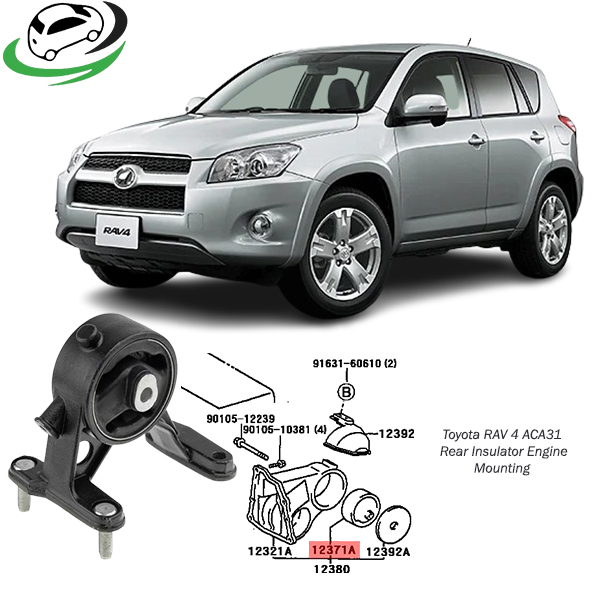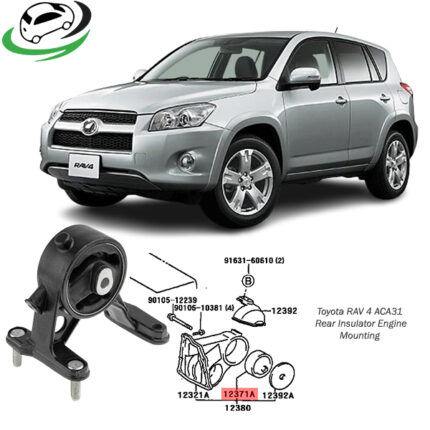-9%
Get Toyota RAV 4 ACA31 Rear Insulator Engine Mounting 12371-28210 in Kenya
The rear insulator engine mounting, commonly referred to as the rear engine mount, plays a crucial role in the engine’s stability and the overall comfort of the vehicle’s ride. This component, often part of the engine mounting system, helps support the engine while absorbing and dampening vibrations produced during operation. Let’s dive into the details of the rear insulator engine mount, its functions, components, types, and maintenance needs.
1. Understanding the Role of the Rear Engine Mount
The rear engine mount, like other engine mounts, is a connector between the engine and the vehicle’s chassis. Unlike the front mounts, the rear insulator mount is positioned closer to the firewall, which typically bears a greater amount of engine torque and vibration. Its primary functions include:
- Supporting the Engine: The rear engine mount is responsible for holding the rear portion of the engine in place. This allows for an even weight distribution and support across the engine’s mounting points.
- Dampening Vibrations: As the engine operates, it produces vibrations that could transfer through the chassis and into the cabin if not managed. The rear mount, equipped with materials that absorb vibrations, reduces noise and provides a smoother ride.
- Enhancing Stability During Acceleration and Deceleration: By keeping the engine stable, the rear engine mount ensures that the engine doesn’t shift excessively, which could otherwise affect handling, especially during quick acceleration or braking.
2. Components of the Rear Engine Mount
A typical rear insulator engine mount has the following components:
- Metal Brackets: These brackets provide the foundational support and are typically bolted to the engine block and chassis. They ensure the mount stays securely connected.
- Rubber or Elastomer Insulator: This is a key feature that acts as a cushion to absorb engine vibrations. Rubber is the traditional choice, but newer mounts may use other elastomer materials or even hydraulic or fluid-filled insulators.
- Hydraulic/Fluid Chamber (for Hydraulic Mounts): Many modern engine mounts have a fluid or hydraulic component that further dampens vibrations. This type of mount offers superior vibration control compared to solid rubber mounts.
3. Types of Rear Engine Mounts
Engine mounts come in various types, each suited to different driving conditions and vehicle types:
- Solid Rubber Mounts: These mounts use rubber insulators to absorb engine vibrations. They are more common in smaller, lighter vehicles and are generally more cost-effective.
- Hydraulic/Fluid-Filled Mounts: In this design, a fluid-filled chamber inside the mount further dampens vibrations. Hydraulic mounts are preferred for larger, more powerful vehicles and provide a smoother, quieter ride.
- Active or Electronic Mounts: Found in high-performance or luxury vehicles, active mounts contain actuators that adjust the damping level in real time based on driving conditions. While rare in rear mounts, they are sometimes employed in modern, complex mounting systems for maximum comfort.
4. Benefits of a Properly Functioning Rear Engine Mount
A well-maintained rear engine mount offers a range of benefits:
- Improved Comfort: By effectively dampening vibrations, the rear engine mount ensures that the vehicle’s occupants experience minimal noise and vibration, enhancing the overall comfort.
- Enhanced Handling: A stable engine means that it won’t shift significantly during quick maneuvers, contributing to improved vehicle control, particularly during sudden braking or turns.
- Prolonged Engine and Component Life: Engine mounts help to prevent unnecessary wear and tear by reducing the engine’s movement. This reduces the stress on other components, such as the exhaust system and transmission, helping to extend their lifespans.
- Reduced Cabin Noise: With effective vibration dampening, the rear engine mount minimizes the amount of engine noise that enters the cabin, creating a quieter ride.
5. Signs of a Failing Rear Engine Mount
Engine mounts are exposed to stress and high temperatures, which causes wear over time. Common signs of a failing rear engine mount include:
- Increased Vibration: If the rubber or fluid-filled insulator has worn out, it may fail to absorb vibrations, leading to increased noise and vibration in the cabin.
- Excessive Engine Movement: A broken or loose rear engine mount can allow the engine to move more than normal, which might be felt during acceleration or deceleration.
- Clunking or Banging Noises: As the mount deteriorates, it may fail to hold the engine securely, resulting in clunking noises when driving over bumps or during sudden braking.
- Engine Misalignment: A weakened mount may cause the engine to sit at an odd angle, affecting the alignment of connected components, potentially causing issues with the exhaust or transmission.
6. Installation and Replacement Considerations
Replacing a rear insulator engine mount requires professional expertise, as it involves handling heavy engine components and careful alignment. Here are some key points:
- Alignment: The mount must be aligned perfectly to avoid stressing other components. Proper alignment ensures the mount can provide stable support.
- Torque Settings: During installation, bolts must be torqued to the manufacturer’s specifications. Overtightening or under-tightening can lead to premature mount failure.
- Lift Support: The engine typically needs to be lifted slightly during mount replacement, so the process requires proper tools to ensure the engine remains stable throughout.
7. Maintenance Tips for the Rear Engine Mount
While engine mounts are built to last, there are ways to extend their life:
- Avoid Aggressive Driving: High torque loads from quick acceleration and deceleration can place excess stress on the engine mounts.
- Inspect Regularly: During routine maintenance, check the mount for visible signs of wear, such as cracks in the rubber insulator or signs of fluid leakage from hydraulic mounts.
- Address Oil Leaks Promptly: Exposure to oil can degrade rubber components over time, so addressing any leaks that could affect the mount is essential.
8. Replacement Options: OEM vs. Aftermarket
When it comes time to replace a rear insulator engine mount, you’ll have the choice between OEM (original equipment manufacturer) and aftermarket parts:
- OEM Mounts: These are manufactured to the exact specifications of the original mount, ensuring fit and performance similar to the factory part. OEM mounts tend to be more expensive but provide assured compatibility.
- Aftermarket Mounts: These can vary widely in quality. While some offer excellent value, others may not meet the same standards as OEM parts. It’s crucial to select a reputable aftermarket brand to ensure durability and performance.
9. Cost of Replacement
The cost of a rear engine mount varies based on the type, vehicle make, and model. Generally, hydraulic mounts cost more due to their complexity. In addition, labor costs can be significant because of the process involved in lifting the engine and securing the mount.
Conclusion
The rear insulator engine mounting is an essential part of any vehicle, stabilizing the engine, absorbing vibrations, and enhancing overall vehicle performance. Proper maintenance and timely replacement of a worn-out mount are crucial to ensuring a smooth, quiet, and comfortable ride. For vehicle owners, understanding the importance of this component can lead to better driving experiences and can prevent more severe mechanical issues that arise from neglected engine mounts. Whether using OEM or high-quality aftermarket parts, replacing a failing rear engine mount promptly can make a significant difference in the longevity and reliability of the vehicle’s engine system.
Follow us on Facebook for more parts.




